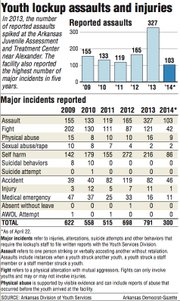Arkansas' largest youth lockup reported more assaults last year than it has in each of the past five years, internal numbers from the state Youth Services Division show.
In 2013, there were 327 reported assaults at the Arkansas Juvenile Assessment and Treatment Center -- an increase of 98 percent over 2012, when the facility reported 165 assaults, and more than double the number reported in each year since 2009, the data show.
The lockup near Alexander serves as the intake point for nearly all of the state's juvenile delinquents and houses about 100 children who are among the state's most violent and behaviorally troubled.
The 2013 spike in assaults was higher than in years when the facility held as many as 43 more youths than it does now. The increase in assaults also occurred in the first full year after the facility was released from the supervision of the U.S. Department of Justice.
The state's figures also show that the lockup is on pace to post similarly high numbers of reported assaults in 2014.
And on Wednesday, agency officials disclosed that a facility employee had been fired in April because of allegations of assaulting a youth.
Tracy Steele, the director of the Youth Services Division, said that the increase in assaults is one of his primary concerns and that his staff has been researching its cause for months.
"I don't think you can pinpoint any one thing and say it's the reason," said Steele, who became director midway through 2013.
Steele said the increase is partly the result of better reporting of occurrences at the lockup, a practice instituted in 2012 and 2013 at the urging of an outside consulting group.
But Steele said he also believes that the lockup has become home to more-violent youths in the past few years as total commitments to the Youth Services Division have fallen nearly 200 since 2009.
"That reduction came by way of a lot of nonviolent kids being out of the system. Since they're out of the system, what you're left with then is kids who are more violent, more disruptive and have a tendency to get involved in more incidents," Steele said. "Is that the total reason for the increase? I don't know. I think it's a contributing factor."
For the past seven years, G4S Youth Services, a Tampa, Fla.,-based company has operated the Alexander center. The company's current contract, under which it has been paid about $10 million a year to run the lockup, expires next year.
Youth Services Division officials have praised the work of G4S in recent years, saying it was instrumental in turning the facility around, especially the center's once-troubled education system.
The education services and other shortcomings in mental- and behavioral-health care led to a federal judge ordering that the facility be placed under Justice Department supervision from 2003 through 2012.
On Wednesday afternoon, the newspaper contacted a representative for G4S about the assault figures after a reporter met with Steele.
Richard Barnett, the company's assistant facility manager in Alexander, said G4S officials would like to discuss the assault figures in detail but didn't feel they were given enough time Wednesday to fully respond.
The assault figures in the Youth Services Division's data come from "major incidents" reported by G4S in accordance with its state contract.
Assaults are classified by the agency as one person striking or being verbally aggressive toward another without retaliation by the victim. An assault can be youth against youth, youth against staff or staff against youth.
The numbers do not offer any detail about particular types of assaults, including the severity of any injury. For instance, a youth shoving another youth could be included in the assault figures along with an altercation that caused serious bodily harm.
The assault figures were included in "major incident" data obtained by the Arkansas Democrat-Gazette using the state Freedom of Information Act.
The Youth Services Division classifies major incidents as "actual or attempted escape, assault, injury (accidental or intentional), fight, attack, any suicide attempts, suicidal comments or suicidal ideations, or any act, event or condition that poses a risk to health or well-being of the juvenile."
More than other units
According to the data, the state's largest youth lockup has accounted for an increasingly larger portion of the major incidents reported at the Youth Services Division's two correctional facilities and six juvenile treatment centers over the past five years.
In 2009, the lockup accounted for 55 percent of the major incidents at the eight facilities. That proportion increased year over year until 2013, when the lockup accounted for 71 percent of the major incidents.
Over that time, the lockup also has seen more major incidents.
In 2013, the Alexander facility accounted for 791 major-incident reports, the highest of any of the past five years. Assaults made up 41 percent of the episodes in 2013, the largest share of any of the 12 categories of major incidents.
Self-harm was the next most prevalent major incident at the facility in 2013. There were 216 reports of self-harm, down from 272 the year before. The facility also reported 121 fights and 16 instances of physical abuse in 2013.
On Wednesday, Steele said that some of the increase in assaults involves youths striking staff members, about which he's particularly worried because it could make if more difficult to hire teachers if they don't feel safe at the facility.
While he takes the spike in major incidents seriously, Steele cautioned that the Alexander facility is predisposed to have more major incidents simply because it houses most of the state's worst youth offenders. The population includes several children who may have been sent to the facility because they caused trouble at other facilities.
"If they come there as a result of incidents [elsewhere], the chance that they're going to be involved in incidents certainly goes up," Steele said.
He added that the center also houses some youths involved in gangs who can be responsible for several episodes because they wield so much influence with their peers. Steele called the scenario a "throw the rock and hide your hand" situation.
"You get three or four of the wrong kids in there who have some kind of affiliation, they may very well be responsible for multiple incidents, but their name never shows up," Steele said.
The rise in assaults and other major incidents at the youth lockup is one reason Steele said he has recommended that the Youth Services Division create four additional staff positions to monitor the agency's contractors.
At present, two employees monitor the contracts of all the division's contractor-operated facilities.
The additional positions would include one monitor housed at the Alexander facility.
"That will be the only facility that they monitor. They will do it every day, every incident," he said, noting that it would be the first time a monitor has been housed full time at the center.
The recommendation for more monitors has not yet been approved, nor has a total cost been determined, but Steele said top leadership in the state Department of Human Services, which oversees the Youth Services Division, has been receptive to the proposal.
Steele said he also wants to give his agency more control over its contractors including whichever company is chosen to operate the Alexander facility after G4S' current contract ends June 30, 2015.
Steele said the new contract, which is expected to be ready to go out for competitive bid in January, will likely include requirements for contractors to track trends, such as the assault numbers and other major incidents.
Steele said he's also considering including in the contract the ability for the division to impose administrative or financial sanctions on uncooperative contractors.
"This is not only the largest facility, but the largest investment of public funds. We want to do everything we can to make sure these kids are as safe as possible," he said.
Abuse allegation
On Wednesday, the Youth Services Division declined to release the number of staff-on-youth assaults, citing confidentiality laws.
But Human Services Department officials did confirm that G4S had fired a staff member because of allegations that the employee assaulted a child.
The employee, Eddie Malvin, had worked at the lockup since 2008 and was a unit manager when he was fired April 9.
"Mr. Malvin was fired following an incident where there was an allegation of staff-on-client assault," said Amy Webb, spokesman for the Human Services Department.
Webb said that the episode occurred more than a month before Malvin's firing and that he wasn't placed on administrative leave immediately after it happened.
Instead, he was moved to another shift and kept away from the youth who made the allegations, she said.
Webb said that G4S' policy is to place an employee on immediate administrative leave if an assault is corroborated by video or witness evidence. If such evidence isn't brought forward to support the allegations, then the staff member is reassigned to another shift during an internal investigation.
"We believe they followed their policy in this instance," Webb said.
A Section on 06/12/2014


